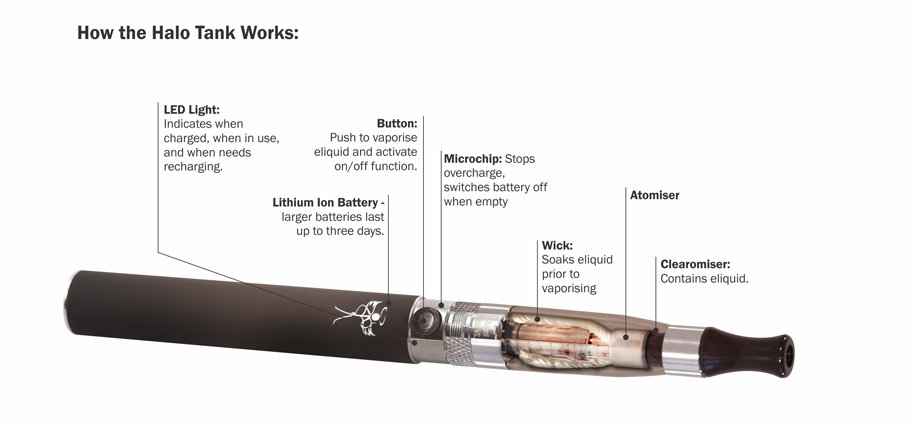Vapor 101
What exactly is vaporizing, "vaping", or an electronic cigarette? We're glad you asked. There are hundreds of products out there in thousands of configurations that all serve the same purpose: to deliver nicotine without the harmful effects of smoking. I am going to break it down to the most rudimentary form, and then elaborate for those who want to know every intricate detail. In layman's terms, here are the basics:
1. Electronic Cigarette or Vaporizer: Technically, they both do the same thing, vaporize a liquidized flavored (or flavorless) nicotine (or nicotine free) fluid into a vapor format that is easy to inhale. Initially the most popular electronic cigarettes looked identical to regular cigarettes, but their tobacco and filter were replaced by a battery, a liquid source, and an LED which illuminated the front to simulate the cherry of the cigarette. These are still readily available, the most popular formats being "Blu", "Njoy", "Vuse", and "No. 7's". These are heavily commoditized and readily available at local convenience stores. However, due to their small battery size, cost of replacement filters & fluids, and lack of available "smoke power," they don't work for most smokers and often end up sending people back to traditional cigarettes & tobacco products. Vaporizers, on the other hand, are more advanced, cost effective, scalable, and option intensive. Here are how they compare in a nutshell:
Traditional Electronic Cigarette:

Basic Vaporizer:

That is it in a nutshell. The actual components of a vaporizer are what makes them all so different.
The first and most important component is the battery. 99% are lithium ion, the same battery you find in most laptops or cell phones. Most of the time they are built in to a cylinder that serves as the base of your vaporizer, but some models feature removable batteries. The capacity of the battery is measured in milli-amp-hour (mAh) and describes the length of time your vaporizer will operate. For instance, a 1200mAh battery will operate twice as long as a 600mAh battery. That being said, two different brands that feature 600mAh batteries will not necessarily operate the same length of time, as one brand may be more efficient than another. Additionally, new advanced batteries have variable voltage which we will discuss later. The nominal (average) voltage of lithium ion is 3.6V-3.7V, but on variable voltage models you can regulate your voltage from approximately 3V-5V, increasing or decreasing the amount of vapor produced respectively. This is a great bonus for those who love gigantic clouds of vapor with minimal inhalation effort, but use of higher voltage can decrease your batteries run time exponentially.
The next important component is the type of heating element. When you press the button to initiate the vapor, a signal is sent to the heating element which will raise the temperature of your liquid with a heating coil to the point it vaporizes (instantly). The most popular configuration is a device called an atomizer. Atomizers have to be replaced periodically (2-4 weeks on average). The atomizer will wick the fluid up and heat it with the heating element, a resistance wire or coil. The higher the resistance of the wire/coil, the weaker the cloud, therefore a 1.5 Ohm coil will produce considerably more vapor than a 3.0 Ohm coil.
A cartomizer is typically less expensive and easier to maintain, but has a normal average life of only 2 weeks. As they get worn out, they tend to develop a burnt taste and need to be replaced. They contain the fluid and the heating device all in one rather than a separate tank and heating element. They normally contain a filler material as well, similar to the wick material in an atomizer.
A clearomizer is a transparent tank that holds the fluid, with a metal tube running through it. The metal tube delivers the liquid to the heating element which may be located at either end of the clearomizer. This is sometimes used as a synonym for a "tank".
The next important component to creating vapor is the fluid. These range from 100% Propylene Glycol (PG) to 100% Vegetable Glycerin (VG) with a percentage of nicotine and flavor mixed in. Both PG and VG have their strengths and weaknesses. PG is more popular and has a lower viscosity (not as thick or syrupy) and is more easily absorbed by the wicking material. PG also has no flavor or odor, so it absorbs flavor more easily than VG. Since PG is not as thick, it tends to clog up parts less frequently than VG. One downfall of PG is that it tends to dry out the user's mouth and/or throat. Vegetable Glycerin, having a higher viscosity (thicker), produces significantly more vapor and leaves the user with more moisture intact in their mouth. Almost all eFluids, aka "Juices," are a blend of PG & VG, from 80% PG / 20% VG to 20%PG / 80% VP, with most falling closer to the middle (50/50). We manufacture our liquid with more VG for thicker vapor volume production and a smoother flavor.

